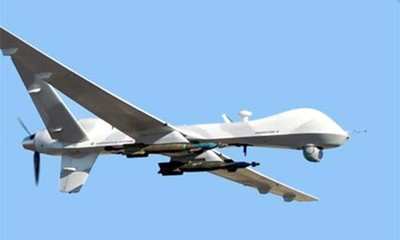Predator Crews Wearing Thin
Critics say the Pentagon is playing the Army and Air Force
against one another, in its quest to deploy more combat-proven
Predator unmanned aerial vehicles to Iraq. That strategy may help
win the battle in the short term... but the Defense Department
could lose the war in the long run.

Those concerns came after Defense Secretary Robert Gates
recently ordered the USAF to deploy almost all its Predator UAVs to
the Middle East, as part of 'surge' efforts to put a decisive end
to the ongoing Iraq War.
While the Predator itself is immune to the effects of extended
deployments and long hours, the crews guiding and servicing the
aircraft aren't... and some officers warn Gates those issues
threaten the long-term viability of the Predator program, one of
the true success stories of the war on terror.
 Predators are used in a
range of roles over Iraq and Afghanistan, mostly in observation of
insurgent forces and locations of roadside bombs. A few
hunter-killer 'Reaper' UAVs, armed with rockets and other explosive
ordnance to use against insurgent ground forces, have also seen
action.
Predators are used in a
range of roles over Iraq and Afghanistan, mostly in observation of
insurgent forces and locations of roadside bombs. A few
hunter-killer 'Reaper' UAVs, armed with rockets and other explosive
ordnance to use against insurgent ground forces, have also seen
action.
As they say, success breeds success... or, the desire for more
success. One example of that strategy is the German Luftwaffe,
which cut back training efforts in World War II in order to get
more pilots in the air, sooner.
We all know how that turned out... and Col. Chris Chambliss,
commander of the Air Force's Predator wing, does not wish to see
history repeated.
Some officers said pressure from Gates resulted in one plan that
could have taken the Air Force down a path similar to the German
Luftwaffe, which cut back training in World War II to get more
pilots in the air.
"That was the end of their air force," Chambliss told The Los
Angeles Times.
Aero-News has reported before
on the ongoing struggle between the Air Force and Army, over which
branch of the armed forces should ultimately control deployment of
unmanned aerial vehicles. The Navy and Marines also want a piece of
the UAV action.
The Army wants all the UAVs it can have, to provide cover for
ground forces. Gates largely supports that mindset. The Air Force
counters, however, that merely sending more UAVs into battle, with
no clear end in sight, will tax its resources even more... though
some officials have also called for more Predators to be sent
overseas, for fear of losing ground to the Army.
One such plan to increase Predator deployments to 36 planes, up
from 22 -- which, in turn, would have shut down training operations
in the US -- was scaled back in January.
A senior Air Force official, speaking on condition of anonymity,
told the Times such brinkmanship may prove counterproductive very
quickly.
"The leadership has to be careful," said the official. "If you
keep on pushing them and pushing them and pushing them, and they
say, 'Yes, yes, yes, yes,' at some point, they're going to break.
Because they ain't going to say no until they break. No one wants
to say 'uncle.' "
While the so-called "all-in" approach favored by USAF Chief of
Staff Michael Moseley has not been fully implemented, aspects of it
already have. The Air Force has already extended tours of duty for
Predator crews in Nevada, and has recalled former crewmembers who
had completed their tours, and moved on to other assignments.
Predator and Reaper crews have also seen their assignments
frozen... meaning those who have already flown UAVs for three years
must remain on station in Nevada for at least two more years.

The Air Force admits that scenario isn't likely to encourage
much sympathy, compared with front-line foot soldiers serving
15-month tours in Iraq and Afghanistan... but the long hours flown
by Predator crews pose their own risks.
"Now we're saying: 'Hey, you guys are just going to be here
until we stop,'" said Chambliss, comparing the open-ended tours of
duty to "a prisoner with a finite term versus a prisoner with a
life sentence."
 SpaceX to Launch Inversion RAY Reentry Vehicle in Fall
SpaceX to Launch Inversion RAY Reentry Vehicle in Fall Aero-News: Quote of the Day (04.23.24)
Aero-News: Quote of the Day (04.23.24) Aero-News: Quote of the Day (04.20.24)
Aero-News: Quote of the Day (04.20.24) ANN's Daily Aero-Linx (04.20.24)
ANN's Daily Aero-Linx (04.20.24) Aero-News: Quote of the Day (04.21.24)
Aero-News: Quote of the Day (04.21.24)





